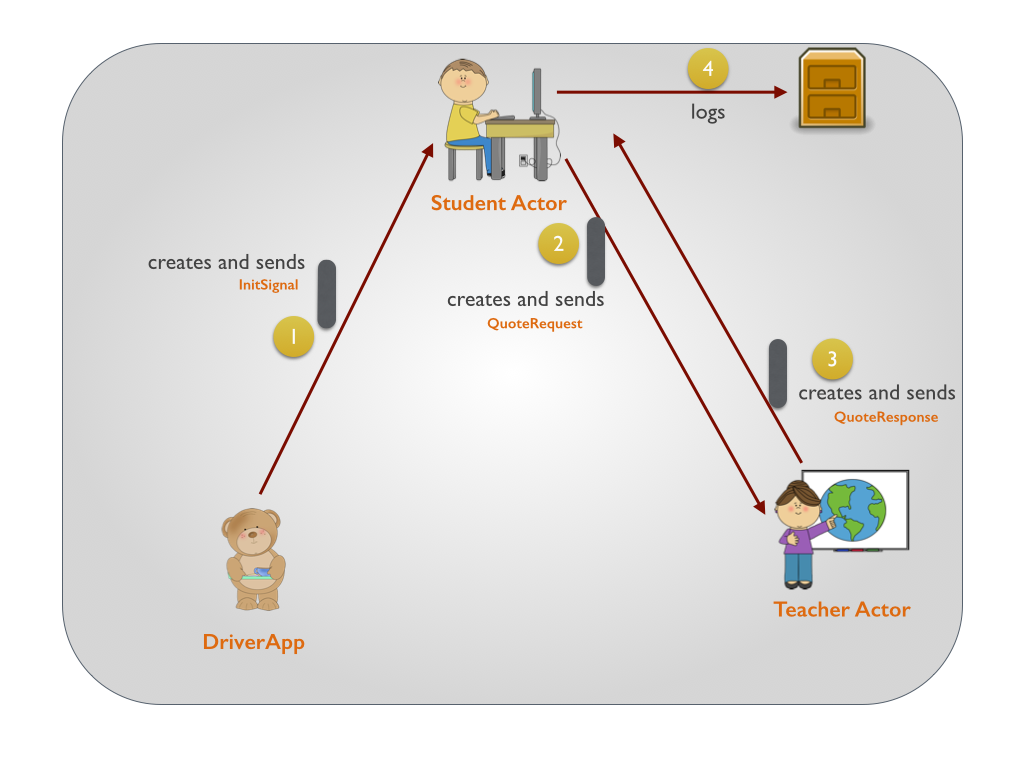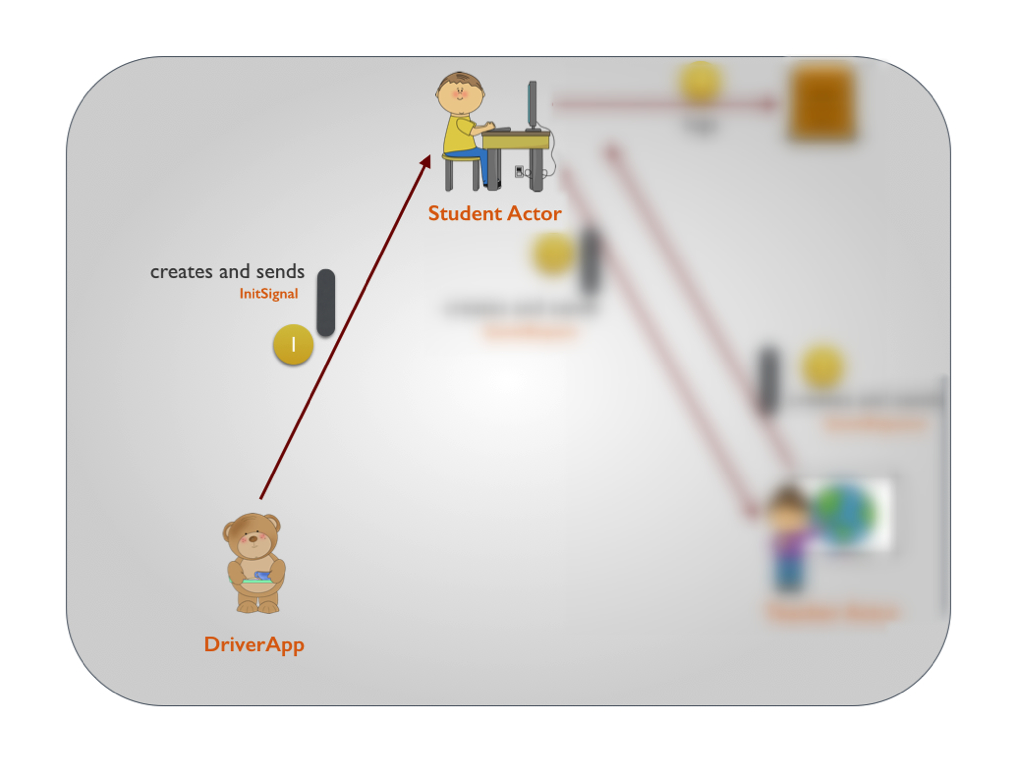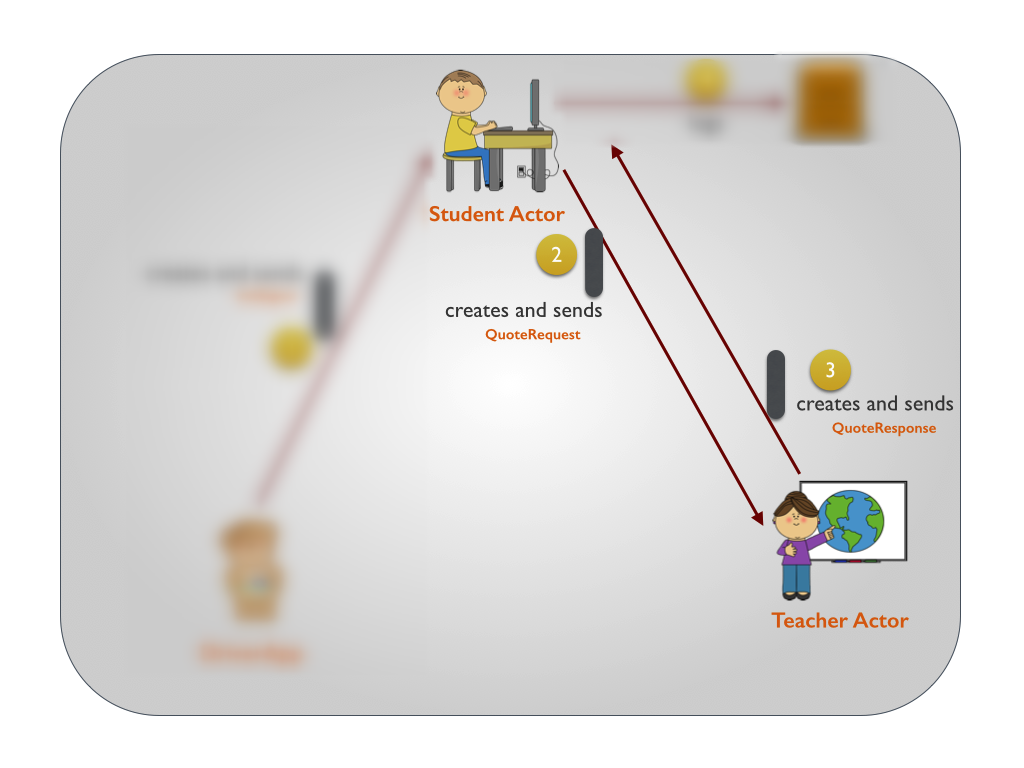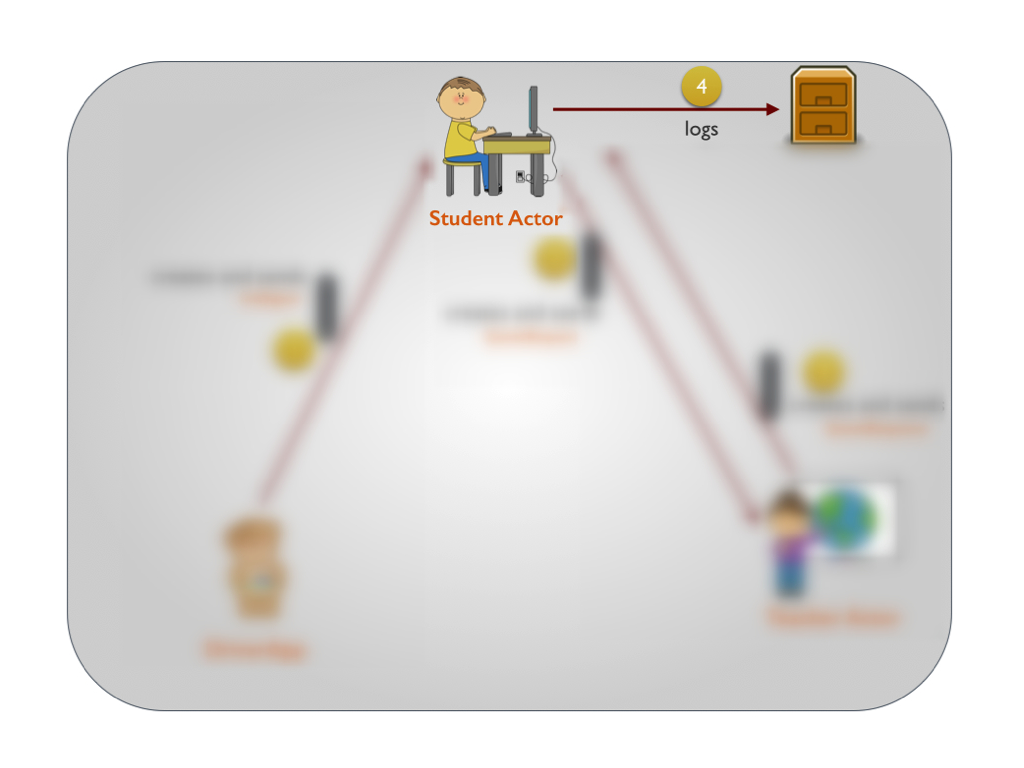Akka筆記之請求與響應
英文原文連結,譯文連結,原文作者:Arun Manivannan ,譯者:有孚
前面我們講到了Actor的訊息傳遞,並看到了如何傳送一條fire-n-forget訊息(也就是說,訊息傳送給Actor後我們就不管了,不從Actor那接收響應)。
技術上來講,訊息傳送給Actor就是希望能有副作用的。設計上便是如此。目標Actor可以不做響應,也可以做如下兩件事情——
1. 給傳送方回覆一條響應(在本例中,TeacherActor會將一句名言回覆給StudentActor)
2. 將響應轉發給其它的目標受眾Actor,後者也可以進行響應/轉發/產生副作用。Router和Supervisor就是這種情況。(很快我們就會看到)
請求及響應
本文中我們只關注第一點——請求及響應週期。

這張圖說明了我們這次要做的事情。為了簡單點,圖中我並沒有畫出ActorSystem, Dispatcher以及Mailbox。
1. DriverApp將一條InitSignal訊息傳送給StudentActor。
2. StudentActor響應InitSignal訊息並將一條QuoteRequest訊息傳送到TeacherActor。
3. 正如前面所說的那樣,TeacherActor會回覆一個QuoteResponse。
4. StudentActor將日誌列印到控制檯或者logger裡。
同樣的,我們會寫一個測試用例來驗證下它。
現在我們來仔細地分析下這四個步驟:
1. DRIVERAPP將一條INITSIGNAL訊息傳送給STUDENTACTOR

現在你應該能猜到DriverApp到底是幹什麼的了。它只做了4件事情:
1. 初始化ActorSystem
//Initialize the ActorSystem
val system = ActorSystem("UniversityMessageSystem”)
2. 建立TeacherActor
//create the teacher actor val teacherRef = system.actorOf(Props[TeacherActor], "teacherActor”)
3. 建立StudentActor
//create the Student Actor - pass the teacher actorref as a constructor parameter to StudentActor val studentRef = system.actorOf(Props(new StudentActor(teacherRef)), "studentActor")
你會注意到我把TeacherActor的一個ActorRef的引用作為建構函式的引數傳給了StudentActor,這樣StudentActor才能夠通過ActorRef來將訊息傳送給TeacherActor。當然還有別的方法(比如通過Props來傳遞),不過這麼做對後續即將講到的Supervisor和Router來說會方便一點。很快我們會看到子Actor也能實現這個功能,不過那個方法用在這裡並不適合——學生來生成老師,這看起來不太對勁吧?
最後,
4. DriverApp將InitSignal訊息傳送給了StudentActor,這樣StudentActor會開始將QuoteRequest訊息傳送給TeacherActor。
//send a message to the Student Actor studentRef ! InitSignal
DriverClass講的已經夠多了。後面的Thread.sleep和ActorSystem.shutdown就是等了幾秒,以便訊息傳送完成,然後再最終將ActorSystem關掉。
DRIVERAPP.SCALA
package me.rerun.akkanotes.messaging.requestresponse
import akka.actor.ActorSystem
import akka.actor.Props
import me.rerun.akkanotes.messaging.protocols.StudentProtocol._
import akka.actor.ActorRef
object DriverApp extends App {
//Initialize the ActorSystem
val system = ActorSystem("UniversityMessageSystem")
//construct the teacher actor
val teacherRef = system.actorOf(Props[TeacherActor], "teacherActor")
//construct the Student Actor - pass the teacher actorref as a constructor parameter to StudentActor
val studentRef = system.actorOf(Props(new StudentActor(teacherRef)), "studentActor")
//send a message to the Student Actor
studentRef ! InitSignal
//Let's wait for a couple of seconds before we shut down the system
Thread.sleep(2000)
//Shut down the ActorSystem.
system.shutdown()
}
2. STUDENTACTOR響應INITSIGNAL訊息並將QUOTEREQUEST訊息傳送給TEACHERACTOR
以及
4. STUDENTACTOR接收到TEACHERACTOR回覆的QuoteResponse然後將日誌列印到控制檯/logger上來
為什麼我把第2和第4點放到一起來講?因為它太簡單了,如果分開講的話我怕你嫌我囉嗦。

那麼,第2步——StudentActor接收到DriverApp發過來的InitSingal訊息並將QuoteRequest傳送給TeacherActor。
def receive = {
case InitSignal=> {
teacherActorRef!QuoteRequest
}
...
...
搞定!
第4步——StudentActor將TeacherActor發過來的訊息打印出來。

說到做到:
case QuoteResponse(quoteString) => {
log.info ("Received QuoteResponse from Teacher")
log.info(s"Printing from Student Actor $quoteString")
}
我猜你肯定覺得這很像是虛擬碼。
那麼,完整的StudentActor應該是這樣的:
STUDENTACTOR.SCALA
package me.rerun.akkanotes.messaging.requestresponse
import akka.actor.Actor
import akka.actor.ActorLogging
import me.rerun.akkanotes.messaging.protocols.TeacherProtocol._
import me.rerun.akkanotes.messaging.protocols.StudentProtocol._
import akka.actor.Props
import akka.actor.ActorRef
class StudentActor (teacherActorRef:ActorRef) extends Actor with ActorLogging {
def receive = {
case InitSignal=> {
teacherActorRef!QuoteRequest
}
case QuoteResponse(quoteString) => {
log.info ("Received QuoteResponse from Teacher")
log.info(s"Printing from Student Actor $quoteString")
}
}
}
3. TeacherActor回覆QuoteResponse
TeacherActor接收到QuoteRequest訊息然後回覆一個QuoteResponse。
TEACHERACTOR.SCALA
package me.rerun.akkanotes.messaging.requestresponse
import scala.util.Random
import akka.actor.Actor
import akka.actor.ActorLogging
import akka.actor.actorRef2Scala
import me.rerun.akkanotes.messaging.protocols.TeacherProtocol._
class TeacherActor extends Actor with ActorLogging {
val quotes = List(
"Moderation is for cowards",
"Anything worth doing is worth overdoing",
"The trouble is you think you have time",
"You never gonna know if you never even try")
def receive = {
case QuoteRequest => {
import util.Random
//Get a random Quote from the list and construct a response
val quoteResponse = QuoteResponse(quotes(Random.nextInt(quotes.size)))
//respond back to the Student who is the original sender of QuoteRequest
sender ! quoteResponse
}
}
}
測試用例
現在,我們的測試用例會來模擬下DriverApp。由於StudentActor只是列印了個日誌訊息,我們沒法對QuoteResponse本身進行斷言,那麼我們就看下EventStream中是不是有這條日誌訊息就好了(就像上回做的那樣)
那麼,我們的測試用例看起來會是這樣的:
"A student" must {
"log a QuoteResponse eventually when an InitSignal is sent to it" in {
import me.rerun.akkanotes.messaging.protocols.StudentProtocol._
val teacherRef = system.actorOf(Props[TeacherActor], "teacherActor")
val studentRef = system.actorOf(Props(new StudentActor(teacherRef)), "studentActor")
EventFilter.info (start="Printing from Student Actor", occurrences=1).intercept{
studentRef!InitSignal
}
}
}
程式碼
專案的完整程式碼可以從Github中進行下載。
在下一篇中,我們將會看到如何在Akka中使用排程器以及如何通過Kamon來監控你的Akka應用。
本文最早釋出於我的個人部落格: Java譯站

